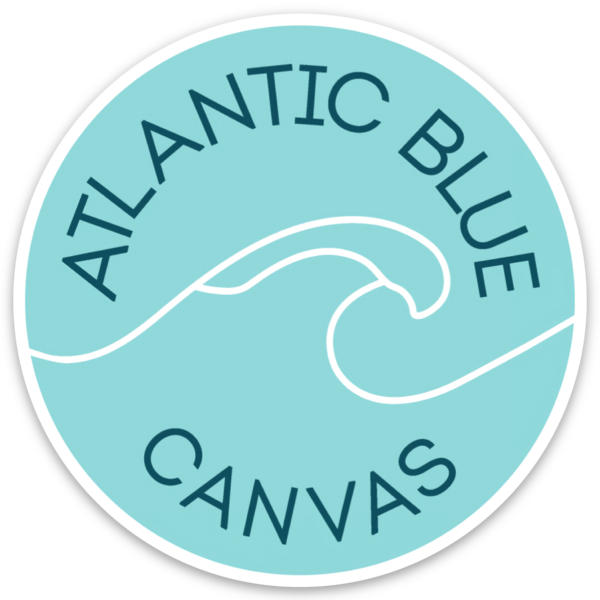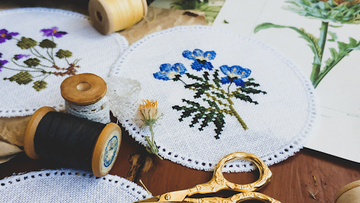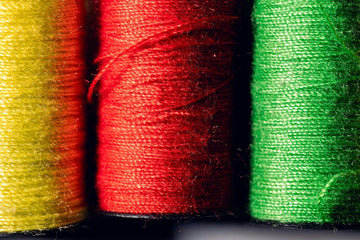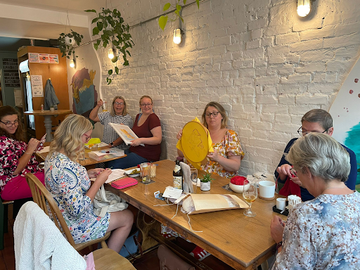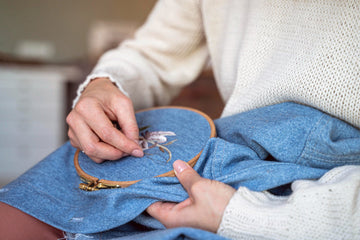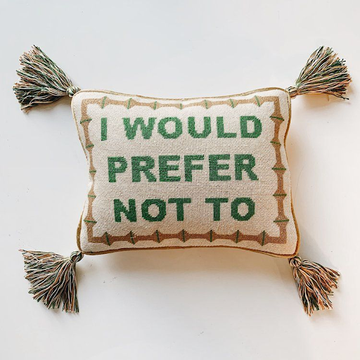Table of Contents
Key Takeaways
- Learn 15 essential needlepoint terms every beginner should know
- Understand canvas types like mono, interlock, and mesh count
- Master core stitches like tent, continental, and basketweave
- Get familiar with common tools, thread types, and needlepoint accessories
- Know the difference between printed, hand-painted, and charted designs
- Discover finishing terms like blocking and how to turn your piece into an ornament, pillow, or framed art
- Perfect for those starting with beginner needlepoint kits or exploring how to needlepoint with confidence
Starting needlepoint should feel fun—not like decoding a foreign language. But if you've ever stared at a stitch guide and wondered what “basketweave,” “warp,” or “mesh count” meant, you're not alone.
Whether you're unpacking your first beginner needlepoint kit or browsing through a needlepoint shop, this guide is your one-stop glossary for the most essential needlepoint terms. No fluff, just clear explanations—so you can stitch with confidence.
Why Learn the Lingo?
Learning the basic language of needlepoint helps you:
- Read stitch guides with ease
- Pick the right canvas and threads
- Avoid beginner mistakes
- Choose kits that match your skill level and goals
If you're just learning how to needlepoint, getting familiar with these terms will make every tutorial, video, and kit feel 10x easier.
Canvas Anatomy
Your canvas is more than just a backdrop—it determines how your stitches sit, how your thread behaves, and how your finished design will look. Understanding the different types of canvas, the role of warp and weft, and how mesh count affects your stitching is essential for both comfort and outcome. Whether you're choosing a beginner needlepoint kit or browsing a needlepoint shop, this foundational knowledge helps you make confident decisions.
1. Canvas
A grid-like fabric used as the foundation for your stitching. Needlepoint canvases come in different mesh counts and styles.
2. Warp and Weft
These are the vertical (warp) and horizontal (weft) threads that make up your canvas. Your needle will pass between these intersections.
3. Mesh Count
Indicates how many holes (or intersections) per linear inch.
- Lower mesh (e.g., 10) = larger holes, great for beginners.
- Higher mesh (e.g., 18) = finer detail, better for advanced stitchers.
Tip: Most beginner needlepoint kits come with 10-13 mesh canvas so you can see and stitch clearly.
4. Mono Canvas vs. Interlock Canvas
- Mono Canvas: Single thread structure—great for varied stitches.
- Interlock Canvas: Woven tighter—ideal for printed designs or smaller items like needlepoint ornaments.
Stitches & Techniques
From the tent stitch to the more advanced basketweave, each stitch offers a different look, feel, and function. Knowing which stitch to use (and why) can help you avoid mistakes and make the stitching process more enjoyable. If you're learning how to needlepoint, mastering a few of these core stitches will instantly boost your confidence and open the door to more advanced techniques later.
5. Tent Stitch
The most basic and widely used stitch. It comes in three versions:
- Half Cross
- Continental
- Basketweave (more below)
6. Basketweave
A version of the tent stitch worked diagonally in alternating directions. Helps prevent canvas distortion. Common in larger projects or beginner kits with full coverage.
7. Continental Stitch
A tent stitch worked in horizontal rows. Easier to learn but can distort canvas if overused.
8. Stitch Guide
A chart or instruction sheet included in most kits that shows which stitches to use and where.
Threads, Tools & Accessories
Ever tried to thread a needle with the wrong type of thread or needle? It’s a quick way to get frustrated. This section breaks down what types of thread are commonly used, what kind of needle is best, and what needlepoint accessories can actually improve your experience. These basics often come in beginner needlepoint kits, but knowing what they are and how to use them ensures you’re not caught off guard.
9. Tapestry Needle
A blunt-tipped needle with a large eye—perfect for sliding between canvas holes without splitting threads.
10. Thread Types
Common types include:
- Wool: Soft and puffy, beginner-friendly.
- Cotton: Smooth, often used in printed kits.
- Silk: Luxurious, for advanced stitchers.
11. Needlepoint Accessories
Includes scissors, frames, threaders, storage bags, and magnifiers. Using the right needlepoint accessories makes stitching easier and more organized.
Design & Kit Terms
Not all needlepoint kits are created equal. Some are hand-painted, others printed. Some come with charts instead of pre-drawn canvases. If you’ve ever felt confused reading a kit description, this section will decode it for you. These terms are especially helpful when shopping for needlepoint kits for adults or exploring more complex projects after your beginner phase.
12. Hand-Painted Canvas
Design is painted directly onto canvas by hand. Usually pricier, but offers rich color and detail.
13. Printed Canvas
Designs are screen-printed or transferred onto the canvas. Affordable and consistent—great for needlepoint kits for beginners.
14. Charted Design
A design that comes with a stitch chart (similar to cross-stitch). You match symbols to colors and stitch accordingly.
Project Finishing & Style
How you complete a needlepoint piece—whether it becomes a needlepoint ornament, pillow, or framed art—depends on techniques like blocking and finishing. This section explains what those terms mean, when you’ll use them, and why they matter. Even if you’re not at that stage yet, it’s good to know how your project can transform from canvas to keepsake.
15. Blocking
The process of straightening and flattening your stitched canvas to prepare it for finishing.
Bonus Term: Finishing
Refers to turning your stitched piece into a final product—be it a needlepoint ornament, pillow, framed art, or stocking.
15 Needlepoint Terms to Know
|
Term |
What It Means |
Where You’ll See It |
|
Canvas |
Base fabric with grid holes |
All kits and accessories |
|
Warp & Weft |
Vertical and horizontal threads of the canvas |
Any canvas description |
|
Mesh Count |
Holes per inch (10–18 common) |
Kit labels, beginner vs pro kits |
|
Mono/Interlock |
Canvas types for stitch flexibility/detail |
Kit listings, ornaments, accessories |
|
Tent Stitch |
Basic diagonal stitch |
Most beginner instructions |
|
Basketweave |
Diagonal tent stitch that protects canvas |
Used in large projects |
|
Continental |
Tent stitch in rows |
Often in how to needlepoint tutorials |
|
Stitch Guide |
Instructions on what stitches go where |
Inside all beginner needlepoint kits |
|
Tapestry Needle |
Blunt needle for canvas work |
Needlepoint shops and kits |
|
Thread Types |
Wool, cotton, silk for stitching |
Inside kits, sold separately |
|
Accessories |
Tools like scissors and threaders |
Needlepoint accessories section |
|
Hand-Painted Canvas |
Artist-painted design |
Premium kit collections |
|
Printed Canvas |
Factory-printed design |
Most beginner and seasonal kits |
|
Charted Design |
Design given in grid chart format |
Embroidery-style kits |
|
Blocking |
Straightening canvas post-stitching |
Final project finishing |
Real-World Tip: Let the Kit Teach You the Terms
The easiest way to learn these terms? Try them out in a project.
Our beginner needlepoint kits are designed to be unintimidating and educational. Each kit includes a canvas, threads, tapestry needle, and a stitch guide that walks you through the process—no jargon, no confusion.
Some kits also include diagrams and tips right inside the packaging, so you’ll pick up vocabulary just by stitching.
Conclusion: Know the Language, Enjoy the Process
Needlepoint has its own rhythm, its own art—and yes, its own vocabulary. But don’t let the terms intimidate you. Once you understand what “mesh count” means or can recognize a “basketweave stitch,” every kit and canvas becomes more approachable.
So whether you're stitching your first needlepoint ornament or leveling up to hand-painted wall art, let the lingo empower you—not overwhelm you.
Ready to stitch smarter?
Browse beginner-friendly kits that come with stitch guides, accessories, and all the clarity you need.
FAQs: Needlepoint Terms for Beginners
Q: Do I need to know all these before I start?
Nope! These terms will make more sense as you go. Start stitching, and refer back to this guide whenever you're unsure.
Q: What's the best stitch for beginners?
The tent stitch is your best friend. Most beginner needlepoint kits rely on it heavily.
Q: Can I mix thread types in one project?
Yes—but make sure your mesh count supports it. Silk on low mesh, for instance, can get messy.
Q: What’s the difference between printed and hand-painted canvas?
Printed = great for first-timers. Hand-painted = ideal when you're more confident and want more color depth.
